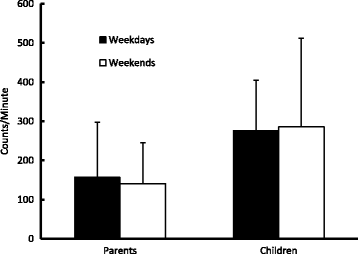Relationships of physical activity and sedentary time in obese parent-child dyads: a cross-sectional study
- PMID: 26851940
- PMCID: PMC4744403
- DOI: 10.1186/s12889-016-2795-5
Relationships of physical activity and sedentary time in obese parent-child dyads: a cross-sectional study
Abstract
Background: Research suggests physical activity is linked to obesity. Further, the physical activity of healthy parents and their children is associated with each other. However, this relationship has not been examined in obese parents and their obese children.
Methods: The purpose of this study was to compare the physical activity and sedentary time of obese, low-income, ethnic minority parents and their children on weekdays and weekend days using accelerometry. Data were obtained from eight rural sites in the middle and eastern part of North Carolina (N.C.), United States (U.S.) from 2007-2010 using a rolling enrollment. One hundred and ninety-nine obese parents (94 % female) and their obese children (54 % female) wore accelerometers simultaneously for three weekdays and one weekend day. Total physical activity, moderate-to-vigorous physical activity (MVPA) and sedentary time and proportions were determined.
Results: Parents' and children's total physical activity and MVPA levels were lower on weekend days than weekdays. Total counts per minute for children on weekdays and weekend days were greater than for parents (p < 0.001). Total counts per minute were more highly correlated on weekend days than weekdays (r = 0.352, p < 0.0002 versus r = 0.165, p < 0.025). Parents' performed MVPA for 14 (SD = ±25) and 9 (SD = ±16) minutes/day on weekdays and weekend days, respectively; children performed MVPA for 37 (SD = ±25) and 31(SD = ±38) minutes/day for weekdays and weekend days, respectively. Correlations between parents and children for MVPA were higher on weekend days versus weekdays (r = 0.253 and 0.177, respectively; p < 0.015). Associations for sedentary time followed a similar trend, with r = 0.33 (p < 0.0002) for weekend days and r = 0.016 (p < 0.026) for weekdays. Associations between obese parent-child dyads on sedentary time were stronger for girls, while associations between dyads on MVPA were stronger for boys. However, formal interaction analyses were not significant (p > 0.13).
Discussion: Since physical activity levels of obese parents and their obese child are somewhat related, especially on weekend days, combined parent-child obesity programs focused on reducing sedentary time could be beneficial, particularly for the child.
Conclusion: In conclusion, this study of the physical activity levels of obese parents and their obese children found some relationships between the parents' and children's physical activity and sedentary behavior patterns, especially on weekend days.
Trial registration: NCT01378806 .
Figures
Similar articles
-
Joint associations between weekday and weekend physical activity or sedentary time and childhood obesity.Int J Obes (Lond). 2019 Apr;43(4):691-700. doi: 10.1038/s41366-019-0329-9. Epub 2019 Jan 31. Int J Obes (Lond). 2019. PMID: 30705394 Free PMC article.
-
Children's moderate-to-vigorous physical activity on weekdays versus weekend days: a multi-country analysis.Int J Behav Nutr Phys Act. 2021 Feb 10;18(1):28. doi: 10.1186/s12966-021-01095-x. Int J Behav Nutr Phys Act. 2021. PMID: 33568183 Free PMC article.
-
Parent-child relationship of directly measured physical activity.Int J Behav Nutr Phys Act. 2011 Mar 8;8:17. doi: 10.1186/1479-5868-8-17. Int J Behav Nutr Phys Act. 2011. PMID: 21385455 Free PMC article.
-
Sedentary behavior and children with physical disabilities: a scoping review.Disabil Rehabil. 2021 Oct;43(20):2963-2975. doi: 10.1080/09638288.2020.1723720. Epub 2020 Mar 2. Disabil Rehabil. 2021. PMID: 32116041
-
Obesity, Physical Activity, and COVID-19.Adv Exp Med Biol. 2024;1457:431-446. doi: 10.1007/978-3-031-61939-7_24. Adv Exp Med Biol. 2024. PMID: 39283441 Review.
Cited by
-
Prevention and Management of Childhood Obesity.Indian J Pediatr. 2018 Jul;85(7):546-553. doi: 10.1007/s12098-018-2636-x. Epub 2018 Feb 19. Indian J Pediatr. 2018. PMID: 29457204
-
Understanding differences between summer vs. school obesogenic behaviors of children: the structured days hypothesis.Int J Behav Nutr Phys Act. 2017 Jul 26;14(1):100. doi: 10.1186/s12966-017-0555-2. Int J Behav Nutr Phys Act. 2017. PMID: 28747186 Free PMC article.
-
The effect of a movement-to-music video program on the objectively measured sedentary time and physical activity of preschool-aged children and their mothers: A randomized controlled trial.PLoS One. 2017 Aug 31;12(8):e0183317. doi: 10.1371/journal.pone.0183317. eCollection 2017. PLoS One. 2017. PMID: 28859091 Free PMC article. Clinical Trial.
-
Childhood obesity in South Asian population.Obes Pillars. 2024 Oct 30;12:100148. doi: 10.1016/j.obpill.2024.100148. eCollection 2024 Dec. Obes Pillars. 2024. PMID: 39734696 Free PMC article.
-
Physical activity and sedentary behaviour amongst children with obesity - exploring cross-sectional associations between child and parent.J Act Sedentary Sleep Behav. 2025 Feb 13;4(1):2. doi: 10.1186/s44167-025-00072-0. J Act Sedentary Sleep Behav. 2025. PMID: 40217557 Free PMC article.
References
-
- World Health Organization . Global status report on noncommunicable diseases. Geneva: World Health Organization; 2014. - PubMed
Publication types
MeSH terms
Associated data
Grants and funding
LinkOut - more resources
Full Text Sources
Other Literature Sources
Medical

